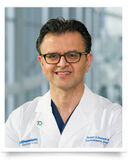“Is It Possible To Fix Atrial Fibrillation After Open Heart Surgery?” Asks Norman
By Adam Pick on November 20, 2012
I just received an interesting question from Norman, who is preparing for his second heart surgery.
In his email, Norman writes to me, “Hi Adam — Is it feasible to correct Atrial Fibrillation (A-Fib) which I’ve had for 5 years since my first, quintuple bypass surgery. I am due to have an aortic valve replacement, mitral valve repair, another bypass graft and Maze procedure for A-Fib . Some reports say Atrial Fibrillation cannot be fixed after 3 years? Thanks, Norman”

To provide Norman an appropriate answer, I contacted Doctor Marc Gerdisch, MD, the Chairman of Cardiovascular and Thoracic Surgery at St. Francis Heart Center in Indianapolis, Indiana. Doctor Gerdisch, who has performed over 1,500 heart valve procedures, specializes in mitral valve repair and atrial fibrillation treatment.

Dr. Marc Gerdisch
In the first part of his response, Dr. Gerdisch identified Norman’s condition and potential treatment options:
Assuming you are continuously in atrial fibrillation, you have what is referred to as longstanding persistent atrial fibrillation. In the past it was called chronic or even permanent afib. Indeed, it is the most resistant to therapy, but it can definitely be treated with excellent results. Because you are undergoing treatment of other cardiac conditions, it is an opportunity to have a highly effective procedure for your afib. The Maze operation was developed by Dr. Cox, 25 years ago. Although it has changed a bit, the Maze procedure remains the gold standard for afib treatment, and the only good therapy for longstanding persistent afib. In December of 2011, the FDA approved the Atricure Synergy bipolar clamp with a specific indication for the treatment of persistent afib, when a patient is undergoing heart surgery for another problem (this is your situation). As part of that clearance, the FDA mandated training courses to ensure proper use of the device. The significance of this is that the Maze can be rapidly completed with the Atricure device, but the procedure must be performed according to a set of specific guidelines in order to be effective.

In the second part of his response, Marc Gerdisch, MD continued to describe the Maze procedure and its efficacy:
The Maze operation was originally performed by cutting through the heart tissue and sewing it back together to form scars in a specific pattern that would break troublesome “circuits” and redirect the path of the heart’s electrical activity. Now, the scars are quickly produced with a combination of radio-frequency and cryo energy. Because you are having a second operation, there will be some adhesions around the heart that can challenge the surgeon somewhat when achieving access to perform the procedure. That said, it sounds like your surgeon will be working in the areas needed. In the final analysis, it will be up to your surgeon at the time of the surgery to decide what is best and safest for you. There are factors affecting efficacy of the Maze procedure. These include the device used to create the lesions, the experience of the operator, the completeness of the lesions (a full Maze operation), the duration of the patient’s afib and the dimensions of the heart chambers.
Many thanks to Norman for his question and a special thanks to Dr. Marc Gerdisch, MD for sharing his clinical expertise with our patient and caregiver community. To learn more about Dr. Gerdisch, click here.
Keep on tickin!
Adam













